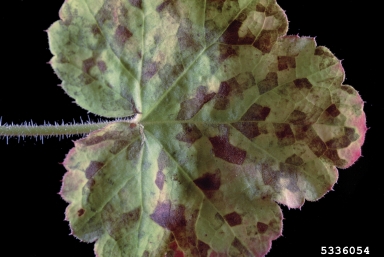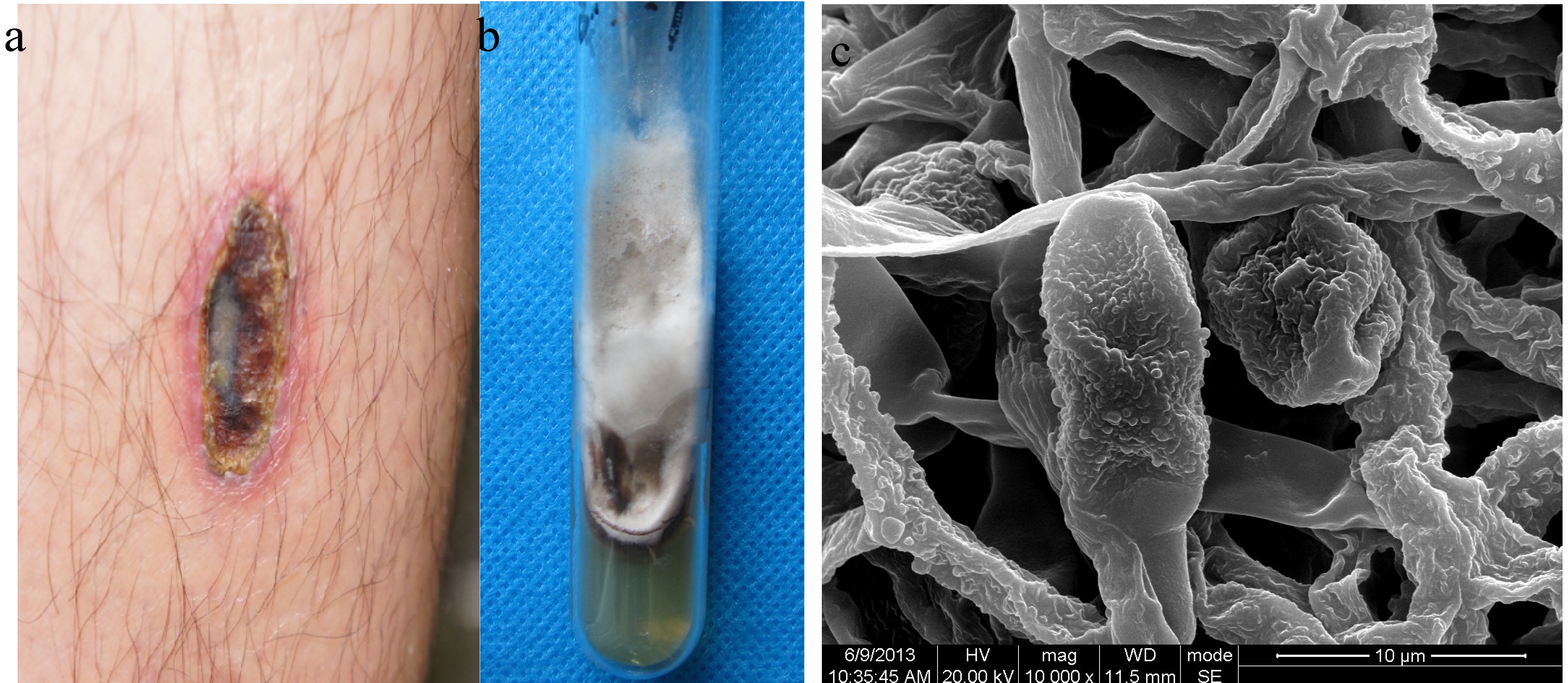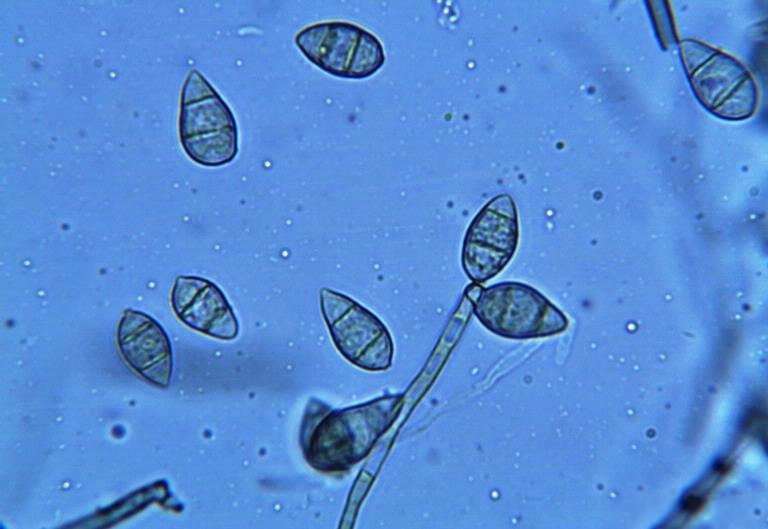|
Leaf Spot
A leaf spot is a limited, discoloured, diseased area of a leaf that is caused by fungal, bacterial or viral plant diseases, or by injuries from nematodes, insects, environmental factors, toxicity or herbicides. These discoloured spots or lesions often have a centre of necrosis (cell death).Horst, R. (2008). Westcott’s Plant Disease Handbook (Seventh Edition.). Springer Netherlands. Symptoms can overlap across causal agents, however differing signs and symptoms of certain pathogens can lead to the diagnosis of the type of leaf spot disease. Prolonged wet and humid conditions promote leaf spot disease and most pathogens are spread by wind, splashing rain or irrigation that carry the disease to other leaves.Lucas, G., & Campbell, L. (1992). Introduction to Plant Diseases Identification and Management (2nd ed. 1992.). Springer US. https://doi.org/10.1007/978-1-4615-7294-7 Description Leaf spots are a type of plant disease that are usually caused by pathogens and sometimes ot ... [...More Info...] [...Related Items...] OR: [Wikipedia] [Google] [Baidu] |
Cherry Leaf Spot
Cherry leaf spot is a fungal disease which infects cherries and plums. Sweet, sour, and ornamental cherries are susceptible to the disease, being most prevalent in sour cherries. The variety of sour cherries that is the most susceptible are the English morello cherries. This is considered a serious disease in the Midwest, New England states, and Canada. It has also been estimated to infect 80 percent of orchards in the Eastern states.Gianessi, L., Williams, & Ashley. (2011, May). Crop Life Foundation. Retrieved from Fungicides Prevent Defoliation of Cherry Trees in Eastern States: http://croplifefoundation.files.wordpress.com/2012/07/14-cherries.pdf It must be controlled yearly to avoid a significant loss of the crop. If not controlled properly, the disease can dramatically reduce yields by nearly 100 percent. The disease is also known as yellow leaf or shothole disease to cherry growers due to the characteristic yellowing leaves and shot holes present in the leaves upon severe ... [...More Info...] [...Related Items...] OR: [Wikipedia] [Google] [Baidu] |
Cercospora Capsici
''Cercospora capsici'' is a fungal plant pathogen that causes leaf spot, known as frogeye spot, on peppers Pepper or peppers may refer to: Food and spice * Piperaceae or the pepper family, a large family of flowering plant ** Black pepper * ''Capsicum'' or pepper, a genus of flowering plants in the nightshade family Solanaceae ** Bell pepper ** Chili .... References capsici Fungal plant pathogens and diseases Eudicot diseases {{fungus-plant-disease-stub ... [...More Info...] [...Related Items...] OR: [Wikipedia] [Google] [Baidu] |
Aphelenchoides Fragariae
Strawberry foliar nematode, or strawberry crimp nematode, is a disease caused by ''Aphelenchoides fragariae'', a plant pathogenic nematode. It is common in strawberries and ornamental plants and can greatly affect plant yield and appearance, resulting in a loss of millions of dollars of revenue. Symptoms used to diagnose the disease are angular, water soaked lesions and necrotic blotches. ''Aphelenchoides fragariae'' is the nematode pathogen that causes the disease. Its biological cycle includes four life stages, three of which are juvenile. The nematode can undergo multiple life cycles in one growing season when favorable conditions are present. The crowns, runners, foliage, and new buds of the plant via stylet penetration or through the stomata can be infected. The best management practices for this disease are sanitation, prevention of induction of the pathogen to the environment, and planting clean seed or starter plants. Importance Foliar nematodes are an important pla ... [...More Info...] [...Related Items...] OR: [Wikipedia] [Google] [Baidu] |
Bipolaris
''Bipolaris'' is a genus of fungi belonging to the family Pleosporaceae. It was circumscribed by mycologist Robert A. Shoemaker in 1959. Species *''Bipolaris australis'' *''Bipolaris brizae'' *''Bipolaris buchloës'' *'' Bipolaris cactivora'' *''Bipolaris clavata'' *'' Bipolaris coicis'' *'' Bipolaris colocasiae'' *'' Bipolaris crotonis'' *'' Bipolaris crustacea'' *'' Bipolaris cylindrica'' *'' Bipolaris euchlaenae'' *'' Bipolaris halepensis'' *'' Bipolaris heveae'' *''Bipolaris incurvata'' *'' Bipolaris indica'' *'' Bipolaris iridis'' *'' Bipolaris leersiae'' *'' Bipolaris micropus'' *'' Bipolaris miyakei'' *'' Bipolaris multiformis'' *'' Bipolaris nicotiae'' *'' Bipolaris novae-zelandiae'' *'' Bipolaris ovariicola'' *'' Bipolaris panici-miliacei'' *'' Bipolaris papendorfii'' *''Bipolaris sacchari'' *''Bipolaris salkadehensis'' *''Bipolaris sorghicola'' *'' Bipolaris spicifera'' *'' Bipolaris subpapendorfii'' *''Bipolaris tropicalis'' *''Bipolaris urochloae'' *''Bipolaris zeae ... [...More Info...] [...Related Items...] OR: [Wikipedia] [Google] [Baidu] |
Septoria
''Septoria'' are ascomycete pycnidia-producing fungi that cause numerous leaf spot diseases on field crops, forages and many vegetables including tomatoes which are known to contract '' Septoria musiva'' from nearby cottonwood trees, and is responsible for yield losses. The genus is widespread, and estimated to contain 1072 species. Pycnidia produce needle-like pycnidiospores. '' Septoria apiicola'' is the cause of late blight of celery. It is characterized by the production of conidia within pycnidia. The symptoms include chlorotic spots that turn brown and necrotic. ''Septoria apiicola'' can survive on seeds. Several species of passion flower are infected by several species of ''Septoria'', and a fungus, which has been going by the name ''Septoria passiflorae'' but which is probably an undescribed species, has been used to control the invasive ''Passiflora tarminiana ''Passiflora tarminiana'' (or banana passionfruit) is a species of passionfruit. The yellow fruits are ed ... [...More Info...] [...Related Items...] OR: [Wikipedia] [Google] [Baidu] |
Alternaria
''Alternaria'' is a genus of Deuteromycetes fungi. All species are known as major plant pathogens. They are also common allergens in humans, growing indoors and causing hay fever or hypersensitivity reactions that sometimes lead to asthma. They are present in the human mycobiome and readily cause opportunistic infections in immunocompromised people such as AIDS patients. There are 299 species in the genus; they are ubiquitous in the environment and are a natural part of fungal flora almost everywhere. They are normal agents of decay and decomposition. The spores are airborne and found in the soil and water, as well as indoors and on objects. The club-shaped spores are single or form long chains. They can grow thick colonies which are usually green, black, or gray. At least 20% of agricultural spoilage is caused by ''Alternaria'' species, with the most severe losses reaching 80% of yield. Many human health disorders can be caused by these fungi, which grow on skin and mucous m ... [...More Info...] [...Related Items...] OR: [Wikipedia] [Google] [Baidu] |
Myrothecium Roridum
''Myrothecium roridum'' is a fungal plant pathogen Plant pathology (also phytopathology) is the scientific study of diseases in plants caused by pathogens (infectious organisms) and environmental conditions (physiological factors). Organisms that cause infectious disease include fungi, oomy .... Myrotoxin B has been isolated from it. References Fungal plant pathogens and diseases Stachybotryaceae Fungi described in 1790 {{fungus-plant-disease-stub ... [...More Info...] [...Related Items...] OR: [Wikipedia] [Google] [Baidu] |
Cercospora
''Cercospora'' is a genus of ascomycete fungi. Most species have no known sexual stage, and when the sexual stage is identified, it is in the genus ''Mycosphaerella''. Most species of this genus cause plant diseases, and form leaf spots. It is a relatively well-studied genus of fungi, but there are countless species not yet described, and there is still much to learn about the best-known of the species. Selected species *'' Cercospora acetosella'' - found on sheep sorrel and other docks *'' Cercospora aciculina'' *'' Cercospora agerati'' *'' Cercospora alabemensis'' *''Cercospora alismatis'' *'' Cercospora althaeina'' *'' Cercospora angreci'' - causes leaf spot of orchids *''Cercospora angulata'' *''Cercospora apii'' - causes leaf spot on celery, and found on other plants, including ''Impatiens'' * ''Cercospora apii'' f.sp. ''clerodendri'' *''Cercospora apiicola'' - causes leaf spot on celery *''Cercospora arachidicola'' - causes peanut leaf spot *''Cercospora arctii'' *''Cer ... [...More Info...] [...Related Items...] OR: [Wikipedia] [Google] [Baidu] |
Pyrenophora
The fungal genus ''Pyrenophora'' includes 191 species, including the following plant pathogenic species: '' P. teres'', '' P. graminea'' and '' P. tritici-repentis''. ''P. teres'' (teleomorph ''Drechslera teres'') makes up to 3 conidia per conidiophore. It infects plants with an appressorium. It grows biotrophically in the first infected plant cell, but then switches to a necrotrophic growth mode. During necrotrophic growth the fungus can only be found in the plant apoplast Inside a plant, the apoplast can mean the space outside of cell membranes, where material can diffuse freely; that is, the extracellular spaces. ''Apoplast '' can also refer especially to the continuum of cell walls of adjacent cells; fluid and ma ... but not within plant cells. References Fungal plant pathogens and diseases Pleosporaceae {{fungus-plant-disease-stub ... [...More Info...] [...Related Items...] OR: [Wikipedia] [Google] [Baidu] |
Pseudopeziza
''Pseudopeziza'' is a genus of fungi in the family Dermateaceae. The genus contains three species. See also * List of Dermateaceae genera A ''list'' is any set of items in a row. List or lists may also refer to: People * List (surname) Organizations * List College, an undergraduate division of the Jewish Theological Seminary of America * SC Germania List, German rugby union ... References External links *Pseudopeziza' at Index Fungorum Dermateaceae genera Taxa named by Karl Wilhelm Gottlieb Leopold Fuckel {{Leotiomycetes-stub ... [...More Info...] [...Related Items...] OR: [Wikipedia] [Google] [Baidu] |
Mycosphaerella Fragariae
Common spot of strawberry is one of the most common and widespread diseases afflicting the strawberry. Common spot of strawberry is caused by the fungus ''Mycosphaerella fragariae'' (imperfect stage is ''Ramularia tulasnei''). Symptoms of this disease first appear as circular, dark purple spots on the leaf surface. ''Mycosphaerella fragariae'' is very host-specific and only infects strawberry. Hosts and symptoms This disease affects strawberry plant foliage causing purple spots ⅛ to ¼ inches across on the upper side of the leaves. At first, the whole spot is purple but as the disease matures the center of the leaf spots on older leaves become tan or gray, then almost white. Lesions on younger leaves remain light brown. When numerous spots merge foliage death can occur; this can stunt or kill infected plants when severe. On petioles, stolons, calyxes, and fruit trusses, elongated lesions may form and interfere with water transport in the plant, weakening the plant and makin ... [...More Info...] [...Related Items...] OR: [Wikipedia] [Google] [Baidu] |
Magnaporthe Grisea
''Magnaporthe grisea'', also known as rice blast fungus, rice rotten neck, rice seedling blight, blast of rice, oval leaf spot of graminea, pitting disease, ryegrass blast, Johnson spot, neck blast, wheat blast, and Imochi ( Japanese:稲熱) is a plant-pathogenic fungus and model organism that causes a serious disease affecting rice. It is now known that ''M. grisea'' consists of a cryptic species complex containing at least two biological species that have clear genetic differences and do not interbreed. Complex members isolated from '' Digitaria'' have been more narrowly defined as ''M. grisea''. The remaining members of the complex isolated from rice and a variety of other hosts have been renamed ''Magnaporthe oryzae'', within the same ''M. grisea'' complex. Confusion on which of these two names to use for the rice blast pathogen remains, as both are now used by different authors. Members of the ''Magnaporthe grisea'' complex can also infect other agriculturally important cer ... [...More Info...] [...Related Items...] OR: [Wikipedia] [Google] [Baidu] |




